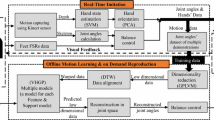Abstract
More and more collaborative robots are making it into factory floors. These safe robots are meant to physically interact with human operators in tasks involving handing over objects or behaving as a third hand. Inverse kinematics is a key functionality for this as the robot has to find joint configurations to reach specific task space targets. Standard inverse kinematics libraries can be difficult to manipulate when controlling redundant actuators as the obtained configurations can be suboptimal in terms of naturalness and operator comfort. We describe a learning approach that allows the operator to easily adjust the postures of the robot by online demonstration. The learned inverse kinematics functions is used in conjunction with standard inverse kinematics libraries to improve the generated postures. A user study shows that human-robot face-to-face interaction is improved by the learned inverse kinematics.
Supplementary material (videos) can be found at http://www.humarobotics.com/en/robotics-lab/baxter-learning.html
Preview
Unable to display preview. Download preview PDF.
Similar content being viewed by others
References
Akgun, B., Cakmak, M., Yoo, J.W., Thomaz, A.L.: Trajectories and keyframes for kinesthetic teaching: a human-robot interaction perspective. In: Proceedings of the Seventh Annual ACM/IEEE International Conference on Human-Robot Interaction, HRI 2012, pp. 391–398. ACM, New York (2012)
Artemiadis, P.K., Katsiaris, P.T., Kyriakopoulos, K.J.: A biomimetic approach to inverse kinematics for a redundant robot arm. Autonomous Robots 29(3–4), 293–308 (2010)
Bocsi, B., Nguyen-Tuong, D., Csato, L., Scholkopf, B., Peters, J.: Learning inverse kinematics with structured prediction. In: 2011 IEEE/RSJ International Conference on Intelligent Robots and Systems, pp. 698–703. IEEE, September 2011
Calinon, S., Billard, A.: Active teaching in robot programming by demonstration. In: The 16th IEEE International Symposium on Robot and Human Interactive Communication, RO-MAN 2007, pp. 702–707, August 2007
Diankov, R.: Automated construction of robotic manipulation programs. PhD thesis, Citeseer (2010)
Morvan, J.: Understanding and communicating intentions in human-robot interaction. M.Sc. Thesis, KTH Royal Institute of Technology (2015)
Nakanishi, J., Cory, R., Mistry, M., Peters, J., Schaal, S.: Comparative experiments on task space control with redundancy resolution. In: 2005 IEEE/RSJ International Conference on Intelligent Robots and Systems, pp. 3901–3908 (2005)
Rethink Robotics. Baxter Research Robot. http://www.rethinkrobotics.com/baxter-research-robot/
Smits, R.: KDL: Kinematics and Dynamics Library. http://www.orocos.org/kdl
Strabala, K.W., Lee, M.K., Dragan, A.D., Forlizzi, J.L., Srinivasa, S., Cakmak, M., Micelli, V.: Towards Seamless Human-Robot Handovers. Journal of Human-Robot Interaction 2(1), 112–132 (2013)
Sucan, I.A., Chitta, S.: Moveit! http://moveit.ros.org
Wrede, S., Emmerich, C., Grünberg, R., Nordmann, A., Swadzba, A., Steil, J.: A User Study on Kinesthetic Teaching of Redundant Robots in Task and Configuration Space. Journal of Human-Robot Interaction 2(1), 56–81 (2013)
Author information
Authors and Affiliations
Corresponding author
Editor information
Editors and Affiliations
Rights and permissions
Copyright information
© 2015 Springer International Publishing Switzerland
About this paper
Cite this paper
Capdepuy, P., Bock, S., Benyaala, W., Laplace, J. (2015). Improving Human-Robot Physical Interaction with Inverse Kinematics Learning. In: Tapus, A., André, E., Martin, JC., Ferland, F., Ammi, M. (eds) Social Robotics. ICSR 2015. Lecture Notes in Computer Science(), vol 9388. Springer, Cham. https://doi.org/10.1007/978-3-319-25554-5_11
Download citation
DOI: https://doi.org/10.1007/978-3-319-25554-5_11
Published:
Publisher Name: Springer, Cham
Print ISBN: 978-3-319-25553-8
Online ISBN: 978-3-319-25554-5
eBook Packages: Computer ScienceComputer Science (R0)




